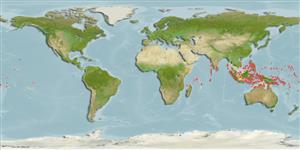>
Blenniiformes (Blennies) >
Tripterygiidae (Triplefin blennies) > Tripterygiinae
Etymology: Norfolkia: Named for the Norfolk Island ( In 1953 Henry W. Fowler named this new genus on a Collection of Fishes Made by Dr. Marshall Laird at Norfolk Island) (R.Bajol, pers.comm. 04/2016).; brachylepis: Named for the scales on the pectoral fin base (Latin 'brachium' for upper arm and 'lepis' for a scale of a fish) (R. Bajol, pers.comm. 04/16)..
More on author: Schultz.
Environment: milieu / climate zone / depth range / distribution range
Ekologi
laut berasosiasi dengan karang; kisaran kedalaman 1 - 25 m (Ref. 90102), usually 2 - 7 m (Ref. 13227). Tropical; 16°N - 15°S
Indo-West Pacific: widespread; from the Red Sea to South Africa; from Sri Lanka, the east and west coast of Australia, Indonesia, southern Japan and east to the Marshall Islands, New Caledonia and Fiji.
Size / Weight / umur
Maturity: Lm ? range ? - ? cm
Max length : 7.3 cm TL jantan/; (Ref. 11441)
Duri punggung (Keseluruhan (total)): 18 - 19; duri punggung lunak (Keseluruhan (total)): 10-11; Duri dubur 2; Sirip dubur lunak: 20 - 21. This species is distinguished by the following characters: D IV + XIV-XV + 10-11 (IV+XV+11); A II, 20-21 (21), spine length half of the rays; pectoral rays 16, dorsalmost 2-3 and ventral most 7 simple, remainder branched once; pelvic rays bound together by membrane for less than one-fourth of length of shorter ray; lateral line pored scales 21-24 (22), terminates between 2nd and 3rd dorsal fins; notched scales and 14-19 (16); total lateral scales 32-35 (34); dentary pores 5-6 + 1 + 5-6; orbital and nasal cirri palmate and about as large as pupil diameter; dorsal fin also with cirri at tips of spines; head 2.9-3.6 (3.3) in SL, eye 3.0-3.9 (3.3), maxilla 2.3-3.0 (2.6) and snout 3.3-4.9 (3.8) in head length (Ref. 88983).
Adults inhabit coral or rock, often under ledges, on clear lagoon and seaward reefs (Ref. 13227). Eggs are hemispherical and covered with numerous sticky threads that anchor them in the algae on the nesting sites (Ref. 240). Larvae are planktonic which occur primarily in shallow, nearshore waters (Ref. 94114).
Holleman, W. and S.V. Bogorodsky, 2012. A review of the blennioid fish family Tripterygiidae (Perciformes) in the Red Sea, with description of Enneapterygius qirmiz, and reinstatement of Enneapterygius altipinnis Clark, 1980. Zootaxa 3152:36-60. (Ref. 88983)
Status IUCN Red List (Ref. 130435)
ancaman kepada manusia
Harmless
penggunaan manusia
Perikanan: tidak ada kepentingan
informasi lanjut
AcuanBudidaya airprofil budidaya airStrainGenetikaElectrophoresesDiturunkanPenyakit-penyakitPengolahanNutrientsMass conversion
mitraGambarStamps, Coins Misc.Suara-suaraCiguateraKecepatanTipe renangArea insangOtolithsOtakPenglihatan / visi
Alat, peralatan
laporan khas
muat turun XML
Sumber internet
Estimates based on models
Preferred temperature (Ref.
123201): 27.6 - 29.3, mean 28.7 °C (based on 1848 cells).
Phylogenetic diversity index (Ref.
82804): PD
50 = 0.5625 [Uniqueness, from 0.5 = low to 2.0 = high].
Bayesian length-weight: a=0.00562 (0.00258 - 0.01228), b=3.08 (2.89 - 3.27), in cm total length, based on LWR estimates for this (Sub)family-body shape (Ref.
93245).
Trophic level (Ref.
69278): 3.2 ±0.4 se; based on size and trophs of closest relatives
Daya lenting (Ref.
120179): Tinggi, Waktu penggandaan populasi minimum kurang dari 15 bulan (Preliminary K or Fecundity.).
Fishing Vulnerability (Ref.
59153): Low vulnerability (10 of 100).
Nutrients (Ref.
124155): Calcium = 246 [122, 544] mg/100g; Iron = 1.36 [0.67, 2.48] mg/100g; Protein = 18.4 [17.2, 19.7] %; Omega3 = 0.103 [0.046, 0.236] g/100g; Selenium = 43.2 [15.9, 109.2] μg/100g; VitaminA = 61.1 [15.9, 225.8] μg/100g; Zinc = 2.89 [1.69, 4.58] mg/100g (wet weight);
